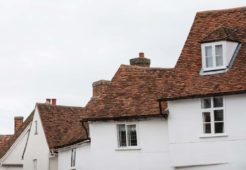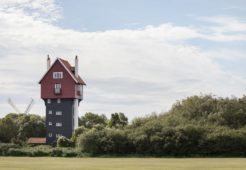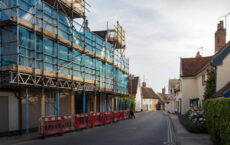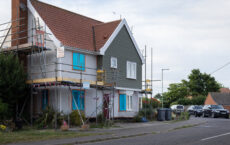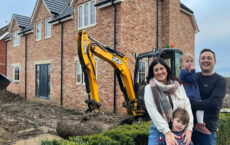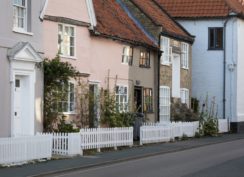The redevelopment of brownfield sites is now a priority for the UK, in order to meet government targets for new home builds as well as protect the environment, but what exactly are brownfield sites and what are the implications of building on them?
What is a brownfield site?
Brownfield sites are previously developed land, often used for industrial, commercial, or even agricultural purposes, but that now lay derelict and redundant.
By contrast, greenfield sites have not been previously built upon. As you might guess from the name, they are often (although not always) green, open spaces.
Brownfield sites can frequently be found in abandoned areas of towns and cities and surprisingly in more rural areas too. In fact, if you’ve ever walked past an old disused petrol garage, abandoned storage unit, or agricultural land that’s not in use, whether that be in built up areas or throughout the countryside, there’s a good chance the area is disused and classified as brownfield land. However, that’s not to say that brownfield sites don’t have their value; transforming these areas holds benefits for the community, is more environmentally friendly and is often easier to get planning permission for.
What are the advantages and disadvantages of brownfield sites?
Up there among the most obvious benefits of using brownfield sites is the environmental impact. With an estimated 300,000 extra homes needed per year to meet government targets, and a lack of available green spaces, it’s no surprise brownfield sites are growing in popularity. They’re an ideal way to continue developing whilst preserving the countryside. In fact, research from the Campaign to Protect Rural England (CPRE), has found England has enough brownfield land for one million homes.
At the same time as safeguarding the country’s green spaces, there’s a chance to help regenerate communities. Perhaps unsurprisingly, most local homeowners are more in favour of brownfield than greenfield development, as the former can eradicate eyesores and health hazards, while providing new opportunities.
For these reasons, the stress of planning permission is also alleviated with brownfield sites. Anyone who has previously tried to get planning permission will know that it’s not always easy, and each local authority and even individual planners will have differing views on what is and what is not acceptable in their region. Getting a head start on planning is a real tick in the box for brownfield sites. The government has further expressed their commitment to enabling the use of brownfield sites, by announcing that developers will no longer need to submit a `normal` planning application to build on brownfield sites, if these are being rebuilt as homes.
Another incentive to consider a brownfield site is that they are often much cheaper to purchase than green belt land or land that has already been set aside for residential development. The discount depends very much on the location and type of site, but square foot for square foot, there can be big savings to be had if you’re bold enough to take on a project.
Naturally, however, there are a few things to be aware of when it comes to developing brownfield land.
Whilst the land is often cheaper to buy initially, it may be contaminated. This could be low levels of pollutants, or oils and tars for example. A survey will be needed in order to fully understand what potential contaminants there are. Correctly managed, however, there is no reason why previously contaminated brownfield sites cannot be safely occupied for residential use.
It’s also not unusual for brownfield sites to become something of a harbour for local wildlife too. If bats or owls have taken up residence in a derelict building you may need to undertake a survey and take precautionary measures during the build. This is something to bear in mind as it can sometimes slow the project down a little.
For this reason, brownfield sites are often considered more ‘risky’ by the property industry in general – estate agents, mortgage lenders, surveyors and builders are your friend here and will help you see both the risks and possibilities. A clean up job is usually best left to experts and whilst it shouldn’t be a deterrent, it would clearly need to be included in the budget – although depending on the type of contamination, there are sometimes grants or other financial incentives available.
A greenfield site on the other hand comes with less risk, is considered to be something of a ‘blank canvas’, and can therefore be more attractive. However, there are plenty of brownfield sites that don’t pose any risk of contamination at all and would be a straightforward development opportunity. In short, it’s important to understand exactly what you’re taking on so that you don’t have any unwanted surprises mid build!
What are brownfield registers?
The purpose of the brownfield land register is to provide up-to-date and consistent information on sites that local authorities consider to be appropriate for residential development. Since 2017, local authorities have been required to keep these brownfield land registers.
The brownfield land register includes sites capable of delivering at least five extra dwellings, and all sites must reach certain criteria. For example, these sites must have no ownership issues or legal constraints on the land to prevent development. They must also be considered to be achievable, which means they are likely to be developed within 15 years of being entered on the register.
Local councils have their own brownfield registers, where people can download and view the available sites.
However, research shows they aren’t necessarily common knowledge amongst the public.
What do I need to know about building on brownfield sites?
There are a few things you should bear in mind if you’re a self builder looking to finance a brownfield site project.
Firstly, all brownfield sites need to be assessed by an environmental consultant before redevelopment can take place. They may carry out an analysis of the soil, groundwater and surface water, as well as test for hazardous compounds. Factor both the time and cost of this into your plans. You’ll also need to make sure you’re basing your costs on a self build mortgage, rather than a standard residential product. Most lenders will consider major renovation work, or projects that include a rebuild, under their self build criteria.
In addition, some can be reluctant to lend on brownfield sites, which is why it’s often worth seeking the advice of an intermediary who has expertise in this area. You may also be more likely to be accepted by a mortgage provider who undertakes a manual lending approach because your individual circumstances will be taken into consideration.





